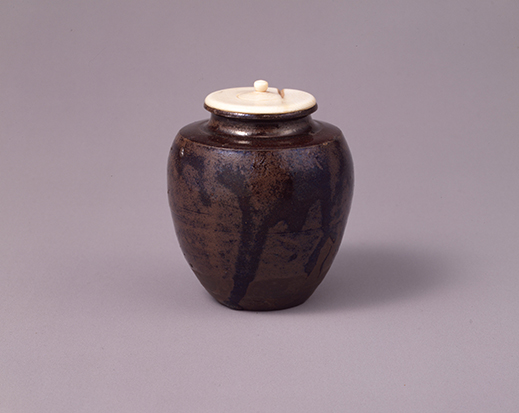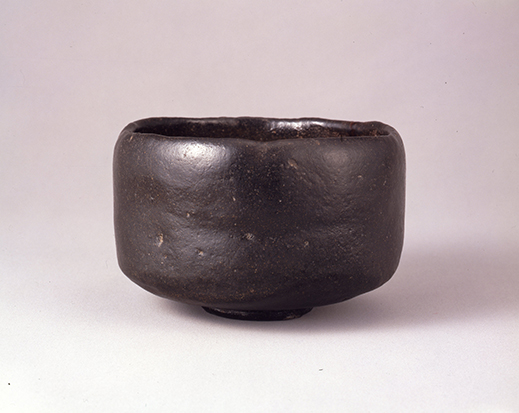 |
Focus features two in-depth reviews each month of fine art, architecture, and design exhibitions at art museums, galleries, and alternative spaces around Japan. |
|
|
 |
 |
 |
The Taste of Simplicity: Tea Utensils through the Centuries
J.M. Hammond |
 |
Fresh water jar with fire mark decoration, Bizen ware, Momoyama period, 16th-17th century |
In the Japanese tea ceremony, the aesthetic aspects of the tea's preparation and presentation, and the design details of the tea room, are as important as the taste of the tea itself.
For those unfamiliar with the etiquette, it can be difficult to know what to focus the eye on. Tea Ceramics -- Appreciating Scenic Kiln Effects, the current exhibition at the Mitsui Memorial Museum in Tokyo, is a good place to start for those wishing to hone their understanding of the visual side of tea culture. Since the Edo period (1603-1867) the Mitsui family has amassed a collection of over 4,000 items, many of them connected to the tea ceremony.
This is the second of two back-to-back exhibitions commemorating the reopening of the museum after a recent closure for renovations that has equipped the Mitsui with a new LED lighting scheme, designed to show off each object on display to full effect.
The Tea Ceramics show brings together about 90 tea items, mainly tea bowls but also tea caddies, water jars, and tea-related works such as paintings and incense containers. It jumps straight in to the exhibits without much in the way of an introduction, so perhaps a little background is in order here.
 |
|
Karamono Katatsuki tea caddy known as "Oso-zakura," originally possessed by the shogun Ashikaga Yoshimasa; Southern Song dynasty, 12th-13th century |
The "scenic kiln effects" of the exhibition's subtitle refers to the practice of connoisseurs likening the color and texture of tea utensils, especially bowls, to aspects of natural scenery. For example, a white glaze with brown pockmarks might be compared to tree stumps dotting a winter snowscape. Especially valued pieces were even given their own, sometimes quite colorful, names reflecting the landscape they inspire in the mind's eye. One tea bowl in the Totoya style is named "Kasumi" (Hazy Scene). Like many others on display in the first gallery, this bowl was made in Korea in the 16th and 17th centuries, during the Joseon dynasty.
Tea bowl named "Kasumi" (Hazy Scene), Totoya type, Joseon dynasty, 16th century |
Among the shoguns and the nobility, the vogue until the mid-16th century was to use ornately decorated tea bowls from China (from where the practice of drinking tea was originally brought to Japan). The tea master Sen no Rikyu (1522-1591) turned this custom on its head, elevating humble rustic handmade bowls into objects of aesthetic interest and contemplation. He was the first to use imported Korean tea bowls in the tea ceremony, and in doing so founded a new tradition of tea aesthetics that continues to this day -- hence the numerous imported Korean vessels on display here. Sen no Rikyu had this amount of influence in no small part because he was in the service of the powerful daimyo Oda Nobunaga, and after Oda's death, he became tea master to the great samurai leader Toyotomi Hideyoshi.
One of the items displayed here, "Kanbayashi-ido," is believed to have been in the possession of Hideyoshi himself. It is a bowl of a type that originated in 16th-century Korea and, because of its high sides and generous depth, became popular in Japan, where it came to be referred to as the O-Ido type, meaning "deep well." The high walls were considered useful for the preparation of tea, as the tea powder needs to be whisked inside the bowl itself.
One thing to look out for in this exhibition is the different shapes of tea cups -- deep or shallow, thick or narrow-rimmed -- on display. Many O-Ido bowls were glazed in light colors, as in the peach and muted pink of the above-mentioned piece.
Another example of the O-Ido type, known as "Shumi" or "Jumonji," has actually been cut into quarters and reassembled in a smaller size. Visible lines of red paste show where the parts of the bowl have been rejoined. This work is believed to have been in the possession of another tea master, Furuta Oribe, a daimyo who studied under Sen no Rikyu and went on to develop his own style of tea ceremony.
 |
|
Tea bowl known as "Shunkan," Kuro-Raku type, Raku Chojiro, Momoyama period, 16th century; Important Cultural Property (no longer on display) |
All of the bowls described so far are from Joseon-dynasty Korea, but it was not long before Japanese potters were encouraged to try their hand. Sen no Rikyu, active in Kyoto, famously had a local tilemaker named Chojiro start making pottery that would reflect the subdued wabi-sabi aesthetic he was promoting. After much experimentation with clay and firing techniques, Chojiro essentially honed in on two basic colors, red and black, and the result was the Kyoto tradition of Raku ware.
There are several examples here by Raku Chojiro, as he came to be called, including one known as "Shunkan." To maximize the idiosyncratic quality of each piece, Raku vessels are traditionally hand-shaped rather than thrown on a wheel. They are also taken out of the hot kiln after only one hour, and rapidly cooled to subject them to stress, creating unpredictable effects on the color and glaze.
 |
|
Tea bowl named "Amagumo" (Rain Cloud), Black Raku ware, Hon'ami Koetsu, Edo period, 17th century; Important Cultural Property |
Also on display is "Amagumo" (Rain Cloud), a later example of Raku ware that is designated an Important Cultural Property. It was made by the famed artist Hon'ami Koetsu, the original driving force behind the Rinpa style of painting. Against a dark background it bears a swathe of deep black.
In addition to tea bowls, several vases can be seen, notably some made in Iga in what is now Mie Prefecture. The rustic quality of these Iga-ware vases made them a popular choice for displaying flowers in tea ceremonies.
Fresh water jar with handles, named "Kankyo," Iga ware, Momoyama period, 17th century |
There are further examples of Iga ware among the fresh water jars on display, including one named "Kankyo." These jars held the water used in making the tea. The inclusion with the Iga-ware jars of some Nanban ware from central Vietnam, imported around the 16th century, illustrates how far and wide Japanese tastes ranged. Interestingly, one of these jars is complemented by a lid (in the Hannera style) from Siam (today's Thailand).
Gourd-shaped tea caddy named "Masukagami" (Clear Mirror), Satsuma ware, carved signatures "Ho" and "Ju," Edo period, 17th century |
Rounding out the exhibition, one gallery is dedicated to tea caddies, and another contains about a dozen incense holders -- small but exquisitely crafted objects, many featuring designs of flowers or animals. The incense they held was put in the brazier where the hot water was prepared, so as to offset the smell of the charcoal and infuse the room with a pleasing aroma.
For confirmed tea enthusiasts and newcomers alike, Tea Ceramics offers a great opportunity to enjoy the richness and variety of Japan's tea culture.
Incense container, alluvial gold bag shape, Oribe ware, Momoyama period, 17th century |
All images are courtesy of the Mitsui Memorial Museum.
|
 |
 |
J.M. Hammond
J.M. Hammond has been researching and writing about Japanese art, traditional and modern, in various media for close to two decades. He has had essays on art and cinema printed in various book projects. These include "A Sensitivity to Things: Mono No Aware in Late Spring and Equinox Flower" in Ozu International: Essays on the Global Influences of a Japanese Auteur (Bloomsbury, 2015) and "The Collapse of Memory: Tracing Reflexivity in the Work of Daido Moriyama" for The Reflexive Photographer (Museums Etc, 2013) [reprinted in the same publisher's 10 Must Reads: Contemporary Photography (2016)]. He has given various conference papers, including at the University of Hong Kong and the University of Oxford.
|
|
 |
|